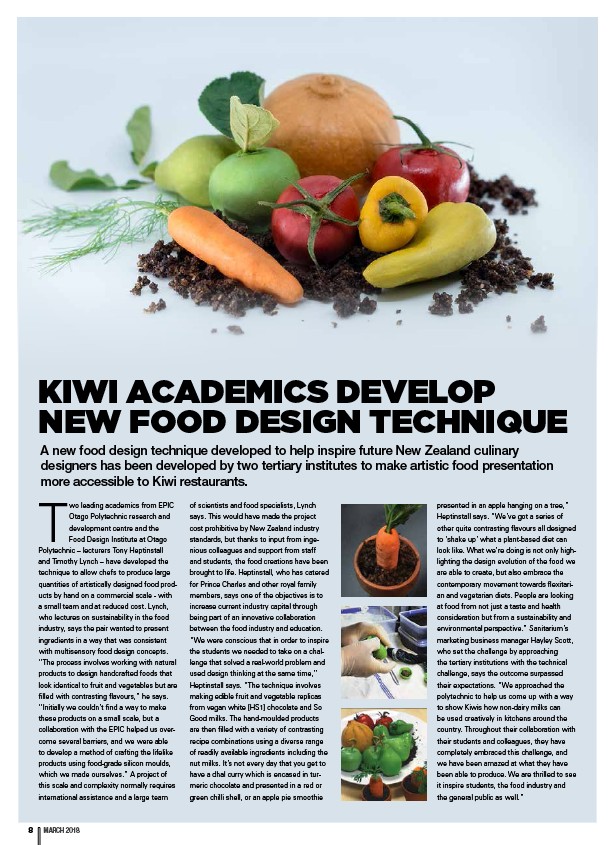
KIWI ACADEMICS DEVELOP
NEW FOOD DESIGN TECHNIQUE
Two leading academics from EPIC
Otago Polytechnic research and
development centre and the
Food Design Institute at Otago
Polytechnic – lecturers Tony Heptinstall
and Timothy Lynch – have developed the
technique to allow chefs to produce large
quantities of artistically designed food products
by hand on a commercial scale - with
a small team and at reduced cost. Lynch,
who lectures on sustainability in the food
industry, says the pair wanted to present
ingredients in a way that was consistent
with multisensory food design concepts.
“The process involves working with natural
products to design handcrafted foods that
look identical to fruit and vegetables but are
filled with contrasting flavours,” he says.
“Initially we couldn’t find a way to make
these products on a small scale, but a
collaboration with the EPIC helped us overcome
several barriers, and we were able
to develop a method of crafting the lifelike
products using food-grade silicon moulds,
which we made ourselves.” A project of
this scale and complexity normally requires
international assistance and a large team
8 MARCH 2018
of scientists and food specialists, Lynch
says. This would have made the project
cost prohibitive by New Zealand industry
standards, but thanks to input from ingenious
colleagues and support from staff
and students, the food creations have been
brought to life. Heptinstall, who has catered
for Prince Charles and other royal family
members, says one of the objectives is to
increase current industry capital through
being part of an innovative collaboration
between the food industry and education.
“We were conscious that in order to inspire
the students we needed to take on a challenge
that solved a real-world problem and
used design thinking at the same time,”
Heptinstall says. “The technique involves
making edible fruit and vegetable replicas
from vegan white HS1 chocolate and So
Good milks. The hand-moulded products
are then filled with a variety of contrasting
recipe combinations using a diverse range
of readily available ingredients including the
nut milks. It’s not every day that you get to
have a dhal curry which is encased in turmeric
chocolate and presented in a red or
green chilli shell, or an apple pie smoothie
VIEW THE VIDEO IN
THE DIGITAL EDITION
A new food design technique developed to help inspire future New Zealand culinary
designers has been developed by two tertiary institutes to make artistic food presentation
more accessible to Kiwi restaurants.
presented in an apple hanging on a tree,”
Heptinstall says. “We’ve got a series of
other quite contrasting flavours all designed
to ‘shake up’ what a plant-based diet can
look like. What we’re doing is not only highlighting
the design evolution of the food we
are able to create, but also embrace the
contemporary movement towards flexitarian
and vegetarian diets. People are looking
at food from not just a taste and health
consideration but from a sustainability and
environmental perspective.” Sanitarium’s
marketing business manager Hayley Scott,
who set the challenge by approaching
the tertiary institutions with the technical
challenge, says the outcome surpassed
their expectations. “We approached the
polytechnic to help us come up with a way
to show Kiwis how non-dairy milks can
be used creatively in kitchens around the
country. Throughout their collaboration with
their students and colleagues, they have
completely embraced this challenge, and
we have been amazed at what they have
been able to produce. We are thrilled to see
it inspire students, the food industry and
the general public as well.”